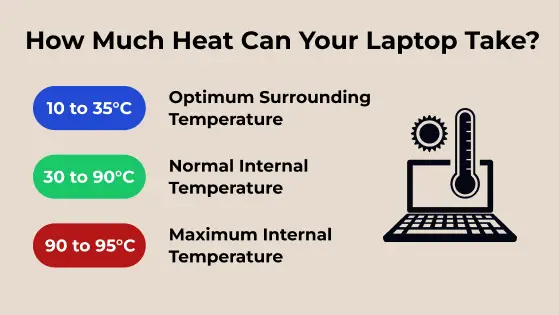Want to sit outdoors while working but not sure if you should use your laptop outside in the sun? Well, we have all your answers so keep reading!
First, let’s address the fact that most people consider the high outdoor temperatures a threat to their laptop’s battery. But let’s get this concern out of our way because most laptops today house a lithium battery, which can safely tolerate a temperature up to 65°C.
However, that’s not to say using your laptop directly under the sun is the best of ideas. A prolonged exposure to high temperatures can, after all, prove harmful for the laptop’s hardware components. If not that, the screen glare due to excessive ambient lighting can cause a terrible viewing experience.
So here’s the deal. You can use your laptop outside in the sun but only under certain suitable circumstances. What circumstances? Go ahead and find out!
How Much Heat Can Your Laptop Take?
According to the HouseBeautiful, Laptops are designed to safely operate in a surrounding temperature ranging between 50 to 95°F (10 to 35°C). If you use your laptop in high ambient temperatures, it will eventually cause damage to its hardware components.
With that said, it is important to note that the surrounding temperature is different from the internal temperature of the laptop. The laptop’s tolerance is greater when it comes to the internal temperature. Most laptops can function up to 90°C without a hiccup. However, an internal temperature higher than that can severely damage the internal components of the laptop, cause thermal throttling, or even thermal runaway at 100°C.

At a Glance
- Optimum Surrounding Temperature: 10 to 35°C or 50 to 95°F [Source]
- Normal Internal Temperature: 30 to 90°C
- Maximum Internal Temperature: 90 to 95°C
Should You Use Your Laptop Outside in the Sun?
As mentioned earlier, you can use your laptop outside in the sun, but only under specific conditions. We’ll discuss those in the next section.
For now, we have to say that you CAN use your laptop in the sun but it doesn’t mean you SHOULD. Excessive heat can wreak havoc on the health of your laptop and its hardware.
If you use your laptop in the sun for long periods of time without taking adequate measures, it can cause several issues.
The most common issues with using a laptop in the sun are listed below.
1- Damages Internal Components

If you continuously use the laptop in a high temperature environment, it will eventually lead to an increase in the internal temperature of the laptop.
A high internal temperature of the laptop can hinder its ability to perform smoothly. The laptop will start lagging or freezing due to excess heat.
In addition to that, a high internal temperature can also melt or damage the internal components of the laptop like the motherboard, GPU, or battery, etc. Over time, this can cause permanent damage to the laptop components and even decrease its lifespan.
2- LCD Damage
This point may be irrelevant if you’re using a laptop with the latest LCD screen as they’re designed with a different type of glass. The modern LCD screens are resistant to the ultraviolet radiations from the sun. They offer protection against 90% of the harmful UV rays.
However, that’s not the case with traditional LCD screens. If you’re using an older laptop model that uses a traditional LCD screen, then your laptop screen is likely to get damaged by the UV radiations from the sun. Constant exposure to the sun rays will cause the LCD panel to polarize and deliver a poor display quality.
3- Thermal Runaway

Thermal runaway is a chemical reaction that happens in lithium batteries which occurs when the temperature of the battery exceeds the normal range. As a result of the high temperature, the battery produces more and more heat, due to which cells enter to uncontrollable and self-heating state. That leads to melting or even explosion (in rare cases).
Thermal runaway is a chain reaction process, which means it cannot be stopped once triggered.
If you use the laptop under direct sun and excessively high ambient temperatures, it will cause a rise in the temperature of the laptop. This in turn can increase the temperature of the laptop’s battery, which can trigger the thermal runaway process.
Note: Even though the extreme cases of thermal runaway are extremely rare, you wouldn’t want your laptop’s battery to be exposed to a consistently high temperature because it can considerably reduce its lifespan in the long run.
4- Required to Use Cooling System
Using external cooling systems to keep the temperature of your laptop down is a very common practice today. If you plan to use your laptop outside in the sun regularly or for a long time, you’ll need some sort of cooling peripherals to keep your laptop within the safe operating temperature range.
However, using cooling systems will obviously cost you some extra bucks, which doesn’t seem the best of ideas. Also, the majority of cooling systems can only bring down the temperature up to 5 or 10°C (at most), which again doesn’t sound so promising if you live in a hot environment.
5- Damage to Plastic Chassis
The chassis of most traditional laptops are manufactured with plastic. This means continuous exposure to higher temperatures outside in the sun can affect the appearance of the plastic. An excessively high temperature can turn the plastic grey or make its color fade away. In extreme but rare cases, constant exposure to heat can also deform the plastic chassis of the laptop.
But again, if you’re a modern laptop user, you don’t have much to worry about. Most of the latest laptops feature a metal chassis that eliminates such risks. However, metal chassis does get significantly hotter than plastic but that’s a different issue.
6- Screen Glare
Screen glare is not much of a serious issue, but it’s still there. Using a laptop outdoors or directly under the sun or any other power source is nearly impossible.
The high intensity of light causes glare or reflection on the laptop screen. The glare makes it impossible to read the screen clearly. Moreover, it also puts strain on the eyes and continuous exposure to glare can be permanently damaging to your eyes.
How to Use a Laptop Under the Sun?
Now that you know the risks involved with using a laptop outside in the sun, let’s have a look at all the conditions that can make you do the same safely.
1- Use a Cooling Pad

If you want to use your laptop under the sun, it is best to use a cooling pad while doing so. A cooling pad draws in cooler air from the surrounding into the laptop and exhausts hot air from the vents. An effective cooling pad can reduce the temperature of a laptop by 10 degrees.
However, you should only use the cooling pad to augment the function of the laptop’s internal cooling system and not solely rely on it to keep your laptop cool.
2- Sit Under a Shade

While it feels nice to soak in the sun directly, it is not suitable for your laptop. If you intend to use your laptop outdoors, avoid sitting under direct sunlight. A continuous exposure to sunlight will increase the laptop’s internal temperature and cause various problems. Therefore, it is best to sit in a shade when using your laptop outside on a sunny day.
3- Use a Laptop Hood

A laptop hood is a lifesaver for you and the laptop. It can be a great tool to protect your laptop from direct sunlight and prevent glare while you can continue basking in the sun without any worries.
A laptop hood works like a hat for the laptop and prevents the sunlight from falling directly onto it. Hence, preventing screen glare issues as well as overheating.
4- Monitor the Laptop Temperature
To ensure the safety of your laptop while you use it outside in the sun, you should constantly keep an eye on the temperature of your laptop.
You can use different software that assess the temperature of the laptop and help the user identify when the temperature exceeds the safe range. Try to maintain the internal temperature of your laptop under 70°C during normal use. If the temperature exceeds 90°C, turn off the laptop and allow it to cool down for a while.
Conclusion
Using the laptop outside in the sun within 10 to 35°C is not much of an issue but make sure you’re taking appropriate measures to ensure the safety of your laptop which we have discussed above in the article. Just make sure to keep the laptop’s temperature within a safe range by using cooling systems and avoiding direct sunlight or higher temperatures and you’ll be good.


Write a Reply or Comment